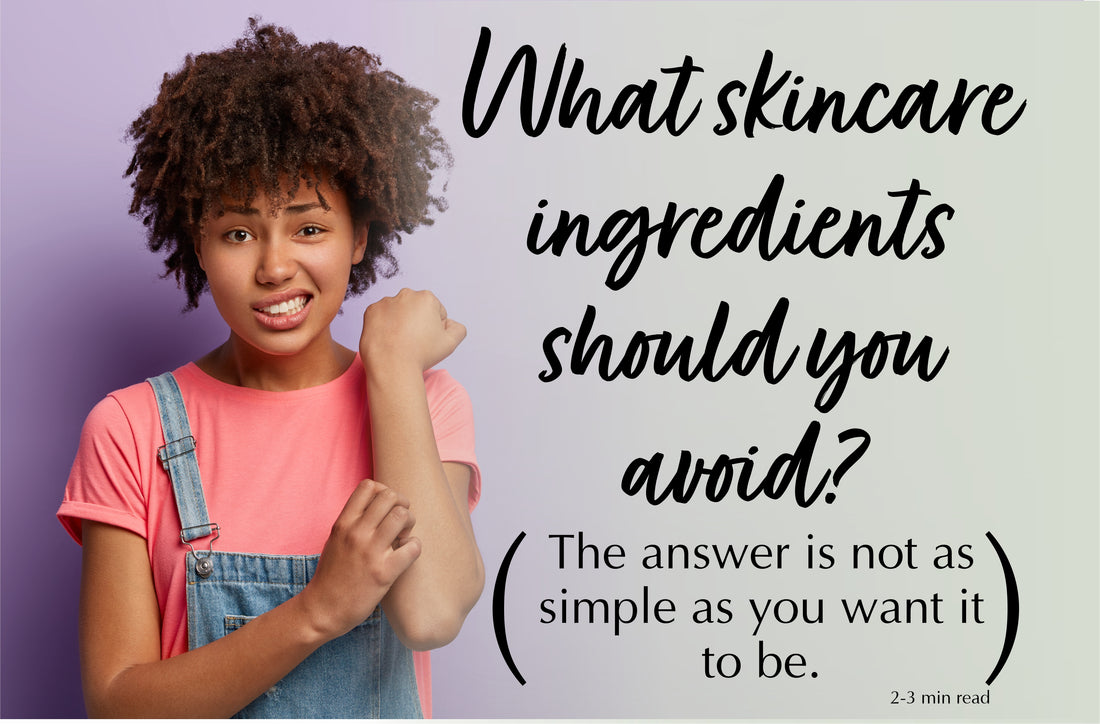
Which skin-care ingredients should you avoid?
Irritants, Allergens, and Endocrine disruptors…. OH MY!
The Complex Nature of Ingredients
It’s tempting to seek a blacklist of ingredients to avoid, but the reality is nuanced. Sensitivities are highly individual, and an ingredient that irritates one person might be benign to another. However, reducing exposure to certain compounds can mitigate the risk of developing reactivity.
This topic is probably far more complicated than most people want it to be, so I am going to attempt to make this as concise as possible.
In general, there are 4 classes of ingredients that have come under scrutiny.
- Allergens
- Accumulative Irritants
- Endocrine Disrupting Compounds or EDC’s
- Formaldehyde releasing preservatives or FRP's.
Allergens: An allergic reaction to a substance may not occur the first time it is encountered but when it happens, it happens swiftly and the symptoms can include hives, itching, redness, sneezing, and in severe cases, anaphylaxis. Because of this clear immune response, allergens can be pinpointed swiftly through testing. Botanicals and fragrances dominate this category. Here are some examples.
Potential irritants: Irritants are substances that can cause skin irritation or sensitivity over time with repeated or accumulated exposure. The reaction is not an immune response but rather a gradual development of irritation or damage to the skin. This makes the source difficult to pinpoint especially since these compounds cannot be identified with allergy testing. Preservatives, botanicals, and fragrances dominate this category. Here are some examples.
Endocrine Disruptors: This one occupies a gray area. Endocrine Disruptors are chemicals, some naturally occurring, some synthesized, which fit into hormone receptors and facilitate biochemical changes that would take place if the hormone that they mimic were present. This effect, however, is not always undesirable. Read more about it here. Symptoms of Endocrine disruption is subtle, individualized, and take a long time to manifest making these the hardest to identify as a problem. Preservatives and essential oils dominate this category. Here are some examples.
Formaldehyde Releasers: Formaldehyde releasing preservatives (FRPs) are compounds that slowly release formaldehyde over time to inhibit microbial growth. These chemicals are also used in chemical straighteners. Heat catalyzes formaldehyde release which is what makes smoothing treatments unsafe unless they are performed in a space with good ventilation and masks are recommended. Preservatives dominate this category.
Now I am going to really confuse you by saying that most of these compounds above are generally safe for most people in trace amounts and some are even necessary in certain cases.
A solvent based product, (99% of all skincare) is NOT safe without a broad-spectrum antimicrobial preservative.
The presence of a solvent (water, oil, alcohol) in a product creates an environment where microbial growth can take place and if a product is going to sit in a warehouse or on a shelf for any period of time, a broad-spectrum preservative is necessary for product safety.
The only way around using broad spectrum anti-microbials is to omit the solvent and isolate the product from any contact or moisture until the moment it is used. (which is exactly what I did)
I know that at this point you are probably more confused than you were before you started but hear me out. When it comes to exposure to these substances, remember this mantra...
How Much? How Often? How long?
How much?
If you identify a potential irritant or allergen on an ingredient list, pay attention to where it is in the list. The closer to the top, the more of that ingredient there is in a formula. Learn how to read an ingredient list.
How often?
Frequency of exposure to these ingredients is not as easy for you to control as you would think. Many brands contain the same fragrance compounds for example but since the FDA does not require a list of individual compounds within the fragrance like the EU does, it is harder to gauge how much exposure you are getting between all of your personal care products. Learn more about fragrances here.
How long?
Follow the directions and make it quick. There are regulations that limit the percentage of certain ingredients such as formaldehyde releasers. For rinse-off products such as shampoos the limit is much higher than it is for products that are meant to be left on. Keep rinse-off products like shampoos and conditioners away from your mouth and eyes by turning and letting them run down your back.
Other variables to consider.
In addition to how much there is, how often you are in contact with it, and for how long you are in contact with it, there are individualistic factors such as inherited traits and barrier function. Factoring in all of these variables is complicated so please reach out to us or talk to your dermatologist if you need help.
Other sources of exposure:
If you are worried about being exposed to these compounds don't just look toward your personal care products. The cosmetics industry is under intense scrutiny, and I would be willing to bet that exposure to EDC's and irritants are more likely to come from other sources such as air fresheners, cleaning products, and off gas from carpet, plastic, and textile coatings.
Read more about Endocrine Modifiers here.
Another note:
Natural soaps can raise the risk of you developing dermatitis as a result of exposure to irritants and/or allergens. Read more about natural soap here.
I know, I know. I'm yanking you around a little bit. just remember...
HOW MUCH? HOW OFTEN?HOW LONG?
WHEN IT COMES TO THESE INGREDIENTS, WHAT IS MOST IMPORTANT IS HOW MUCH THERE IS IN THE FORMULA AND HOW OFTEN YOU ARE EXPOSED, AND FOR HOW LONG YOU ARE EXPOSED TO IT. NOT THAT IT IS THERE TO BEGIN WITH.
Read, and understand your ingredient list. Here is a blog about that
If any of these potentially problematic ingredients are in the lower 2/3 of the list, (which they are in 99.9% of otc skincare) then they have a reduced likelihood of causing any problems unless you are allergic to them or you are over exposed to them.
Brand loyalty can be problematic.
Take the recent Olaplex debacle. Olaplex, like nearly every other product out there, contains some potentially allergenic and/or irritant compounds and always has, however, they have only recently come out with a slew of other products (0-10 with a’s and b’s in between). Brand loyal followers obsessed with retrieving their hair from damage, began slathering on 3-8 layers of Olaplex products every day and then when dermatitis began to develop, instead of employing the “product elimination strategy” they kept right on using them. After all, they hadn’t had any problems with Olaplex before, right? Now there are people out there with massive permanent hair loss and scarring, both physically and mentally, all due to overexposure.
Repeat after me....
HOW MUCH? HOW OFTEN? HOW LONG?
Accumulative irritants, Allergens, and EDC’s are ubiquitous, even in our natural world. You can maintain the health and vitality of your skin by understanding the distinct nature of the symptoms of overexposure, being vigilant about limiting this exposure, and adopting a responsive approach to skincare. This will ensure that it remains resilient and radiant amidst the myriad of topical exposures in our modern world.
Please feel free to reach out to us if you have any questions or concerns and remember to please.......
Go forth and enjoy a quality day!
MBM

